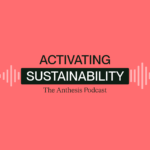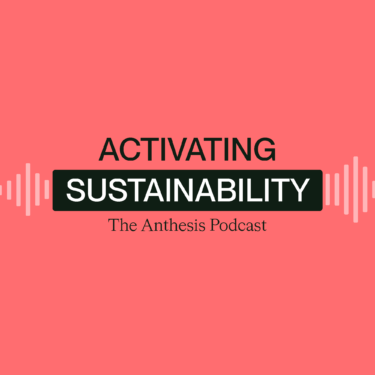
Speakers
Chris Peterson, Director
Cher Mereweather
Jon Duschinsky
Related Topics
Share this episode
In this Activating Sustainability episode, our host Chris Peterson is joined by Cher Mereweather and Jon Duschinsky to share how they have experienced changing priorities in the food system during this decisive decade.

Read the transcript
Chris: Hello, and welcome to Activating Sustainability, the Anthesis podcast. I’m your host, Chris Peterson. We hope that you’re all doing really well. I’m particularly excited about today’s interview with our latest Anthesis partnership, Provision Coalition for two key reasons. First as an organisation, they really exemplify the Anthesis spirit of activating change, facing up to the scale of our challenges and ultimately making sustainability happen.
Second, they’re at the forefront of addressing the many challenges we face on food and food- systems that we really need to address over this decisive decade. To dig into all of this and more I’m joined by Cher Merriweather, CEO of Anthesis Provision and Jon Duchinsky, executive vice president of Anthesis Provision.
Thanks so much for joining the podcast.
Cher: Hi, Chris. Great to see you.
Jon: Yeah, pleasure to be here, Chris.
Chris: Wonderful. Well, maybe to jump in, you could just help us to understand why is food such an important focus for the sustainability journey and efforts.
Cher: You know what the food system is such a critical piece. We actually see it as, if we’re going to get sustainability right, we’ve got to get food right first. And there’s some really important stats that we like to point to on a global level. One that says ‘the food system is the biggest source of greenhouse gas emissions at 33%’. The second is that the food system is the biggest cause of biodiversity loss at 80%. And the third is that the food system is the biggest user of water at 70%.
So when we think about that and environmental sustainability, and then we realize that the food system is actually the most vulnerable to those very factors. That’s why we’ve got to get food right. In addition to the fact that we need to feed ourselves.
Jon: And I think that’s what I would add here, Chris is if we can’t get food right then, there’s not much hope for all the rest of it. We can have other sectors technology manufacturing, all of these are really important, but at the end of the day, you can’t use your iPhone if you can’t eat. And we have to recognize that food lies at the bottom of every other system in the human existence and in the natural world. So we have to get food, right. And there’s a lot to do.
Chris: It’s so interesting hearing, just the scale of those environmental impacts and curious if there’s also that kind of social element that comes in. Do you see it the same way that we’re seeing the environmental justice discussion? Is that coming in on the food side as.
Cher: Absolutely. When we think about the food system, the equity and diversity inclusion is really key to it as well. We know that people are the heart of any business. And right now I would say historically, we’ve seen the food system really looking after their people in a transactional way where it is about you know, show up, do your job, I’ll pay you, as opposed to, how do we work together and regenerate and make it exciting to work here, create positive impact and change the world. That’s where we’re seeing the shift that we need to go.
Jon: Yeah, the food industry; if you think about jobs in food from picking fruit and veg in the fields all the way through to manufacturing, often in sort of cold wet environments, it’s not traditionally been the place that many aspire to work. You work in food because you have to work in food or you work in food because it’s entry level. And we see that particularly in North America, food is one of the highest represented industries for new arrivals into the country for new immigrants. And so there has been a share set, this kind of transactional relationship.
It’s very much a stepping stone to somewhere else. And as a result, we’ve created this system where, I would say a bit of a disconnect between the leadership of the companies and the people who are actually doing the work on the front lines. And it’s been really interesting to see how in the last couple of years with COVID, we’ve begun to recognize the importance of our frontline food manufacturing workers.
We saw the headlines when the food companies were struggling to keep open because of the pandemic. And you start to recognize at that point that actually. People who make our food in relatively difficult conditions. A. We need to take better care of them. And B. We need to recognize that they are really, really important people in keeping our societies and our, and our economies running.
Cher: Absolutely. And if we look at agriculture, the immigrant workers are so key to keeping that alive. And we have often seen that it is the very fact that people don’t want those jobs in North America and that’s a problem in and of itself.
Chris: Well maybe that’s a good spot to kind of transition to what you see as those key challenges within the food sector.
Jon: So the first big challenge is waste. The food industry in North America operates at about 50% waste. That means about half of everything we grow, process, manufacture around food in North America gets wasted and globally share figures about 30%. Is that right?
Cher: It’s about a third. Yeah.
Jon: So just pause for a minute on that. Can you think of another industry, another sector in our economy that operates at that level of waste? Because I can’t. And it’s fundamentally unsustainable as we look at how we achieve feeding a planet that has 9 to 10 billion people on it. If we’re throwing away, half of all the food that we make, and as we said globally, a third, then we’re having to overproduce at massive levels to be able to feed the people on the planet.
So the first thing that we have to look at is waste. And we’ll talk a little bit later, I’m sure Chris, about some of the stuff that’s going on in terms of how to address that challenge, but the first big challenge that the industry’s facing is the waste issue.
Cher: And I would add that it’s not just about the waste of the food itself, it’s the waste of all of the resources that went into producing it. So the energy, the water, the biodiversity impacts. The labor and the movement, the transportation, all of that is wasted in addition to the food itself that’s wasted. And so I think we have to sort of let go of that concept of it. Okay, this is a food waste issue. In fact, it’s a massive resource issue that we’re wasting in addition to the food itself.
Yeah. And that’s such an important point Cher. Because if you think about, okay, so you have a burger in the fridge and it goes past itself by date and it, and it turns and you’re like, okay, I’ve gotta throw it away. Yes, you can be saying, oh, I’m throwing away that small burger that’s not a big deal. it’s a little bit of meat. But when you think about how many hundreds and often thousands of liters of water are required to produce one kilogram of beef. And then you think about what you’re throwing away. It gives a whole different context to that conversation.
Chris: And what’s driving that difference between global and North America? You know, are we the outlier within that space or are there attributes that really differentiate the experience.
Cher: I’m going to say it’s cultural. It’s culture that we have in North America accepted this notion of waste. That’s been my only observation, is that it’s been accepted as this is part of doing business or it’s part of what I have in my kitchen. And I always like to think about the compost bin as being a really important part, but it’s also been a bit of a guilt free option for in the home. And so again, that all speaks to culture, the acceptance of waste, as ‘it’s part of life’.
Jon: Yeah. We could spend the next hour talking about the cultural and behavioural drivers in North American psychology. But if you look back to the fifties, go back to the sixties, how did we advertise things? We advertised a space of abundance. We advertised material economies. We sold the dream that wasting is actually, it’s not a bad thing, because you can afford more. And I mean, how many of us have had a perfectly good iPhone or a perfectly good something; it still works, but we want to go and get the next one. It’s something that we’ve all bought into. And as far as food look at the portion sizes that we provide in North America versus the portion sizes that are provided in other countries. As a Brit, when we used to come to the States and Canada as a kid, I used to love it because you used to get three times more on your plate than you would ever get back home. But of course you’d never eat it all.
Cher: And talking about a child, I remember being frustrated with my mom for giving me a reusable water bottle when all my friends had a juice box. Right? And so that notion of waste was inherited even growing up, right? Yeah.
Chris: No, it was a great point. So waste is a key challenge. Are there others that kind of come to top of mind?
Jon: Yeah. I mean, Cher talked right at the beginning about how vulnerable the food system is to climate. And it’s really interesting cause not only is it a system that wastes massive quantities of what’s produced, at the same time, it, it is the most vulnerable economic system to climate change. Do you just want to read some of those stats through again, Cher? Cause they’re really compelling.
Cher: Yeah, for sure. Again, biggest source of greenhouse gas emissions globally at 33%, biggest cause of biodiversity loss at 80% and biggest user of water at 70%. I mean, that’s massive. And then when we think about the fact that the weather and climate impacts the food system the most, when we get right down to the root of primary agriculture, We can’t grow food if the temperatures are fluctuating, there’s extreme weather, there’s extreme droughts, extreme floods. We are impacted the most by the very system that we are impacting the most.
Jon: Yeah, it’s the complete opposite of a virtuous circle. The food industry is making the most impact on the climate and the climate is making the most impact on the food industry. And it sort of cycles around and cycles around and we have to break that cycle.
Chris: And at the farm level, do you see increasing levels of interventions to try to mitigate those changes that say farmers are seeing et cetera, or do you see the changing locations of where things are being produced?
Cher: My experience on the farm side is that there’s real hesitation for farmers to take on risk. And so there’s this whole school of thought around “we need to shift the best practices in agriculture. We need to be thinking about rewarding or incentivizing farmers for the ecological goods and services, for the value that they’re creating for society.” And I don’t believe that we’ve got there yet. Where we truly understand the values, the impact and the value that the farmer brings to the story. And we’ve got to get to that place where we can incentivize farmers to shift the way that they grow, a and to reward them for the ecological goods and services that they produce for society.
Jon: Yeah. And I think back to the cultural piece as well here; agriculture is going through something of a revolution right now. The new generation that are coming in and taking ownership are looking at agriculture in a different way. After many years of agriculture not being an aspirational vocation, we’re starting to see it come back in as an aspirational vocation, as people start to look for, ‘how do I balance wellbeing, planet, health and food’, and recognizing that these are all the same conversation. This is all the same thing. It’s not about going to the grocery store and eating organic, but on the other side, kind of throwing stuff away, it’s about recognizing the connection between all of our behaviours. About how we show up in the environment, how we show up in terms of our behaviours around waste, how we talk more about the circular economy, but how we show up in this notion of ‘take, make dispose’, which is how we’ve built our economies and this notion of “one health” is really one of these things that’s emerging out. And agriculture is a fundamental driver in that.
I have never seen more bumper stickers in the last six to 12 months saying ‘farmers feed cities’, you see them almost everywhere. And it’s fabulous. It’s a sense that there’s a real connection to how agriculture is driving and how we are connecting ourselves to agriculture again.
Cher: And I think the general awareness at a consumer level, and I’m going to give credit to COVID doing this, of this awareness of how food = health = planet health. And going back to what John talked about in terms of that ‘one health’, I think for the first time people realize that their own health and wellness is driven by the food that they put in their body, which is driven by the health of the planet that grows it. And we’re shifting what’s important to us as a society.
Jon: And that takes us seamlessly to supply chains, of course. Because again, thinking about one of the big challenges, what is the big challenges? Well, we’ve created a supply chain within the food industry, which is fairly uncooperative. Various pieces of the supply chain don’t like to talk to each other, where you have a very large number of relatively small suppliers – 95% of food manufacturers in Canada, and I think the stats similar in the states – are SMEs. And on the other side, they are selling to a very small number of retailers.
So you’ve got a fundamental imbalance in the market economics of that particular piece of the supply chain. And you’ve got distrust that’s grown up in the supply chain and you’ve also got a food system supply chain that has created a system now where you blockade a black sea port and suddenly whole sways of Africa are not getting access to grain.
And I think one of the other things that come out of what Cher was talking about and the pandemic, the recognition of the vulnerability and the lack of resilience in our supply chains is a recognition that we need to move our supply chains to being a little bit more local and shorter. And to not depend on things happening all the way over the other, other side of the world, over which we have very little visibility, transparency, understanding. And certainly we have very little control.
Cher: I think that’s what’s key for me is that our food system is built on a lack of transparency. And so it is not uncommon for a processor or a manufacturer in the middle of the chain to have no idea where their products come from, how they’re made, where they come from, what’s in it. It’s just, “I need that. So I’m going to put it into the product”. And the movement now is to understand all of that lineage. And where does it come from? How’s it made? Where are the details? So we need to build that transparency into the process so that we can start to see the trust coming back in the food system.
Chris: So I’m super keen to jump into how are you approaching those and solving those challenges, but are there any other kind of key challenges that stand out to you?
Jon: Well, we touched on people and if you talk to anybody in the food industry right now, they’ll tell you their biggest challenges is labour. And part of that, a big part of that, is that we’ve created this transactional space where people don’t really want to grow up. I mean, how many people grow up going, Hey, I really wanna work in the food industry!
IT doesn’t really happen. And that’s a shame because feeding people is a truly noble thing to do. So we have to reset that as well and create a space where you can and should be proud to work in making the food that feeds your communities. Particularly if you’re doing it in a way that’s sustainable and is making a social impact.
Chris: It’s amazing to think about these transitions. I spend a lot of time in the utility space and a lot of these same conversations are happening. So, you know, big changes in some of the major industries that we have that have kind of flown under the radar. So one piece that I’m ecstatic to dig into with the two of you is the reputation, the achievements, the work that you all have done to actually change the way the industry views these challenges and how they approach them, and the way that you have methodically implemented various practices that led to activating the industry, reducing impacts, et cetera, and would love to hear from the two of you in terms of what does that journey look like? What are some of the key lessons from that? What are some of the key highlights?
Cher: I’m going to start with the heart of all of this is at the people side. And so early in my career, I can remember being really technical focusing on technology and data. And this is how we’re going to shift things and just getting that pushback from people. And it became very obvious to me that until we are able to shift the mindset and support people through change – because change is hard and people hate change – that we are not actually going to get to those wonderful technical and data driven solutions. And so almost all of the effort that we have built at Provision has really started with the people first. So how do we get clear on why we’re doing what we’re doing, helping companies figure out their purpose, helping them figure out how to engage all of the people in the organization, not just the C-suite – of course we have to start with the C-suite because we need to have that buy-in in order to drive it through the organization – but recognizing that it takes the entire organization to be on board. How do we support through that change? How do we shift the mindset and how do we really support them in that evolution? And that’s been the most challenging and the most rewarding.
Jon: I mean, we’ve just talked about a status quo that’s unsustainable. The only way we’re going to be able to achieve the kind of impact we need to achieve in the next 10 years and beyond is through people, millions of them and change is fundamentally a human endeavour.
It’s fundamentally about shifting the way people think. And if you think about some of the things that we’ve done; really powerful, successful behavioural change. I mean, go back 40 years. Nobody used a seatbelt. Go back 40 years, smoking in offices. It was a thing that we did commonplace. We know how to change mindsets and attitudes. We’ve done it before and we will continue to do it again. We did it collectively through COVID in a way that was unprecedented. And we need to keep that level of unprecedented human change and mindset shift. If we are to have a hope of leaving a planet to our kids and our grandkids that resembles the one we live in today.
So the technical piece of this is absolutely fundamental, because you have to build this on good science. But just go back to some of the moments in the last 10 to 15 years where we’ve moved the needle collectively on awareness of climate change. It wasn’t when the UN published the sustainability development goals. It was when Al gore put out his film. It wasn’t when the UN did X, Y, Z, or when we created a new technical solution. It was when Greta got up and had a rant. And it’s the balance of the science and the technical solutions with a fundamentally human driven behaviour change understanding. We have to bring these two pieces together and, you know, science has come a long way in the pandemic, we keep talking about it. The radical acceleration of the understanding of how to do science communication. During the pandemic to achieve behaviour change. So science communication change; those three pillars, those three steps. If you like the world moved on leaps and bounds in the last three years of figuring out how to connect those three and in the sustainability space, we need to take a leaf out of that book, because if we can think that where business as usual now is going to get the impact we want in 2030, it’s just simply not going to happen.
So to Cher’s point, this is about people and it is about mindsets. And it’s about recognizing that you can lead somebody to the bottom of a mountain and tell them that the world is so much better at the top of that mountain. Give them the route to get to the mountain and watch them not climb it.
Chris: Yep, absolutely. I’m going to put the two of you in the uncomfortable spot of bragging a little bit. Because I’m proud of what you’ve accomplished and would love to hear you unpack a little bit. How do you take that from the 50,000 foot? “Yes. We need to do this”, how have you actually accomplished that? You know, using the Canadian food system as maybe an example of the work you’ve done.
Cher: So the food loss and waste prevention work that we did in partnership with the Centre for Food Integrity, the Walmart Foundation, and Second Harvest was all about understanding the magnitude of food waste that was happening in the food system. Particularly in processing and manufacturing. We wanted to understand why food companies would tell us “I don’t have any waste. I divert it all. It goes to livestock feed. It goes to compost. Biodigesters.” Reframing that question to why are you diverting? So we went in, we did a deep dive assessment in partnership with stewards, 50 food companies. The average amount of waste that we found was the equivalent of $228,000. The magnitude of greenhouse gases, energy, water, all of that, the calories that were lost, we assessed all of that.
We’re now supporting those companies with, ‘did you implement what we found? And if you didn’t, what do you need to make it happen’. Supporting them with change management training, supporting them with the technical expertise that they need to implement. So it wasn’t just about, Hey, there’s a problem, but support you with actually implementing the solutions so we can achieve the real impact that we want to achieve.
Jon: We’re now building on that Chris by prevention is the first stage here. And, and I’m talking about food waste. The prevention is the first stage, but there are many, many food processes that require other ingredients to be transformed. Great example is when you make beer, when you make beer, you need grains. And at the end of the process, those grains are spent. yeah, they’re not used in the final product. So what we call an unavoidable by-product, but they still have a lot of nutritional value. So in the last couple of years, we’ve been focusing as well as prevention on how do we increase upcycling, which is taking those waste by-products of which there are more than 10 million tons a year generated in North America that as Cher said are currently wasted or diverted. And how do we keep those ingredients – because they are ingredients, they’re not waste – in the human food system for as long as we possibly can. So instead of saying, oh, those spent grains are going to go off to some animal feed and it fine makes for some happy pigs. What about, can we keep those grains in the human food system? Can we turn them into bread products? Can we do other things with them that will turn them into human food?
And so on the upcycling side, we’ve been piloting a project now for a couple of years. We just published the results just a couple of weeks ago, which showed that with a relatively small number of companies, we were able to find new homes for about 10,000 metric tons of food.
That a Cher said was previously not being kept in the human food system. And what that demonstrates is the potential here, because the other thing that those 10,000 tons generated was value to those companies roughly around about 10 million dollars of new revenue value every year, by selling those products, rather than having paying somebody to come and pick them up and take them away, which is what you do when you waste them.
So lots of opportunities in this space. Prevent first and then once you’ve prevented all the food waste that you can, and let’s just note here that prevention of food waste has a 14 to 1 ROI on it. Every single dollar you spend on preventing food waste in the food system has a 14 to 1 ROI. And I don’t know many other things in business today that deliver a 14 to 1 ROI other than calling up people who run Blackrock and asking for a blank check.
So it’s a really powerful way for businesses, particularly at this moment where businesses are being squeezed by increasing input costs, by inflation, by all of the challenges that the industry’s being faced with. Prevent first, prevent the food waste, get a 14 to 1 ROI. And then the second thing is to upcycle those by-products into new ingredients.
So that’s some of the stuff that we’ve been doing in that space. And we’re working to create a national infrastructure around upcycling firstly in Canada and then in the States. So that every player in the food system – be that primary agriculture farmers, processors – are able to tap into the opportunity that up cycling represents.
Chris: I think that 14 to 1 ROI speaks so highly to what you’ve been saying throughout. That that mindset shift is so fundamental. And I think so often we think ‘if there’s an economic value, business commercial logic will kind of balance that out’. But I think the 14 to 1 is a great example of just how influential that mindset is. Of like, well, that’s just waste, as you said earlier. Yeah.
Cher: And you don’t even realize how impactful it is to the employees who see the waste. They are frustrated by seeing perfectly good food fall off the line and be on the floor. And then they have to actually clean it up afterwards. And so many of the employees that we talk to are frustrated with the company because they’re wasting. And so there’s also the human engagement component of, we see this as a problem. Help us fix this. And then the employees are excited about being part of the solution and that shift in mindset of ‘it’s just the way it is’ to ‘let’s solve this problem together’.
Let’s tell a really great story for our employees. Let’s tell a great story to our customers. And let’s be real about the world that we’ve been in and how we’ve created those changes. So many companies are afraid to say I had this much waste instead of flipping that and going, you know what? We saw a problem and we attacked it. And here’s how we have come out on the other side.
Chris: So there’s so much of this that I really want to dig into, and I’m hoping you two will come back soon and we can continue this conversation. But maybe just before we wrap up a couple of things, I’d like to just kind of hit on with you. So, one, what I’m hearing is the sense of doing the research, understanding what’s happening, creating that baseline view of what reality really is for people. John, you mentioned building it on good science being really fundamental in the sense of engaging a wider group and Cher what struck me as you were just saying is telling a really good story.
And I’m just wondering if maybe the two of you could speak quickly to, I know you’ve done some circular food events recently, that seemed like a great way of kind of changing that mindset on a big scale. I’m wondering if maybe you could just speak a little bit to that. I’d love to hear how that’s played out and how you see that manifesting as a part of the path.
Cher: I’ll share sort of a, an experience. I guess it started with a great brewery Wellington brewery that we were working. We had eliminated all the beer that was going down the drain and really were trying to figure out what did we do with this spent grain as John alluded to, and literally John and I are in the highway on the highway, in the car, trying to figure out what are we going to do with this spent grain and through various riffing, we decided, you know what we could make an upcycled meal that we serve in a restaurant in the middle of a global pandemic. Sure. Let’s try that. That sounds really fun. And so we took the spent grains. We sent it to a black soldier fly farm created fish feed, sent it to a local fish farm, and then took the fish detritus or the fish poop and sent that to a potato farm. And then we sent some of the spent grains to a local baker.
We ended up with multiple products. We had beautiful rainbow trout. We had sourdough bread. We had potatoes. We went to one of the largest B Corp certified restaurant chains in the local area, which is the Neighbourhood Group. We said here, we’ve got some really cool upcycled products. What can your chefs do?
And we served. Three beautiful different meals. All from that spent grain coming out of Wellington brewery in three different restaurant chains. It was super fun in the middle of a global pandemic but you know, nothing’s going to stop us.
It was really
Jon: cool to be able to sit and have a pint of beer and the food that was literally grown from the waste for making that pint of beer and to be able to tell the story to people. And then the point around telling the story. So when the restaurant, who were very good at communicating this story, and they trained up their weight stuff, communicated this to the folks who were coming in, it became the biggest selling thing on their menu by a country mile because people were like, this is so cool. I want to be part of this.
Cher: And it tasted great too.
Jon: Yeah. That, that does help. Doesn’t it?
Chris: I think that’s always that fundamental piece. Right. And so important going forward. So maybe just before we wrap up and that’s such a great story, I love you sharing it. So thank you for That. Cher, you had mentioned some really interesting insights around COVID and that experience I’d love to just kind of capture quickly the moment, if we could
Cher: You know what, when I look back and think about the positive things that have happened through COVID, it’s really brought people together around community. It’s really brought people that awareness of supply chain. I remember my, my husband coming home from the grocery store and literally being frazzled and upset about the fact that the grocery store shelves were empty. This was the first time in his experience in his life that he’d ever seen an empty grocery store shelf. And it was quite off putting for him. And just that general awareness of the vulnerability of the food system and where our food comes from and the health and wellness, all of that, I believe is a positive impact coming out of COVID that we can now say, this is why it’s so critical that we make these changes. This is why we need to focus, really focus in the next, what is it? 3,600 days between now and 2030. There’s so much that we need to do in so little time and the impetus, I feel like it is here.
I’ve been doing sustainability my entire career, and I’ve never seen more engagement from the general population than I do right now.
Jon: And I think Chris, this speaks to something that we touched on earlier, which is that we need to approach this challenge. There isn’t an unprecedented challenge. We need to approach it across the industry with everybody having a voice at the table and everybody having a space, which is why we’re launching LEAP, which is we’re called it the leap academy. And the leap academy is going to be a space where everybody in the food system – be that a farm hand, or be that somebody who’s working on the line in a, in a, in a manufacturing facility, a chef, a CEO of a company – can find a space to learn, be challenged, compare and discuss and exchange with others, so that we create essentially, what is a community of people who are committed to a more sustainable food system?
We’re launching this right now. The goal is that every single company that we work with, we train every single person in their company to be enrolled in their sustainability journey. And that’s not something that just sits in the C-suite and that we create literally a movement of people across North America who are in the food system, who are making change in the food system. Cher talked about the frontline staff being the ones who were the most frustrated when there was waste happening. Those are the people who are going to be part of driving the change. We need to connect them into the conversation.
We need to give them a space where they can come to play in this and they can have a voice in this. So that’s what the leap academy is all about and say training and a community space that we’re launching. Just this point for the food industry. There may be applications of it beyond the food industry, but we want to create a space where everybody in food can have their opportunity to be part of figuring out how we feed tomorrow’s communities sustainably.
Cher: And that they’re part of the impact, part of the solution.
Chris: I, love it. Cannot wait to hear more about it. Definitely need to have you come back and unpack that a little bit further. Sounds incredibly ambitious, but having spoken to you both, a number of times, dug into the provision coalition and the merger within Anthesis, know that you have all the skills to make it happen. And I’m grateful for kind of the ambition and the drives down the highway that the two of you take from time to time.
So, thank you both so much for joining today. Really appreciate it. Appreciate the time and look forward to connecting again with you soon.
Cher: Thanks, Chris. It’s been fun.
Jon: Thanks Chris. See you soon.
Chris: And thank you all for joining, you can find links to a number of the resources and case studies we talked about in today’s podcast, in the show notes, and can Reshare John or myself via first dot last name @anthesisgroup.com.
Thanks again, and take care.
Inside this episode
- Diversion, equity, and inclusion in the food system.
- The biggest challenges facing the food industry.
- Impacts of human-driven behavioural change.
- Food waste prevention and upcycling.
If you have any feedback on the podcast, get in touch with our host Chris Peterson at: Chris.Peterson@anthesisgroup.com















